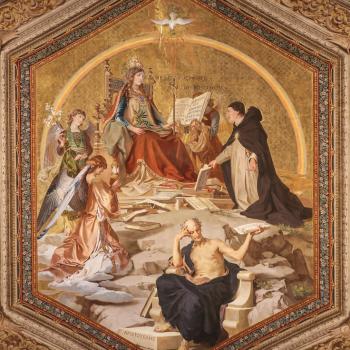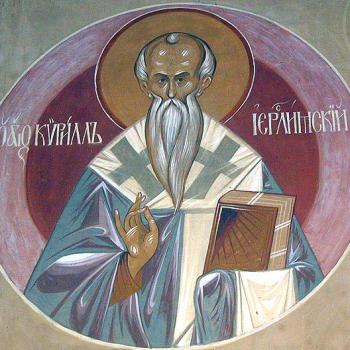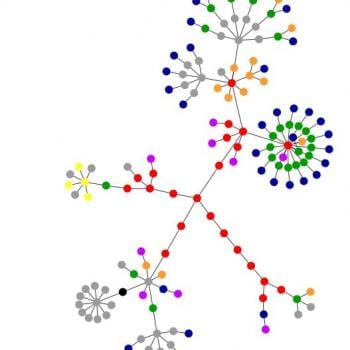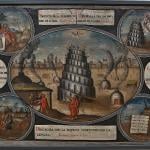
There is a strange notion that many Catholics have been led to believe: if a teaching of the church is not officially proclaimed through an ex cathedra declaration by the Pope (or, perhaps, through an ecumenical council), that teaching can be easily shrugged off, ignored or rejected without question. Only infallible teachings matter. Anything else is optional, and as they are optional, one doesn’t even need to justify their denial. Similarly, many Catholics think that it is the words themselves, taken in the most superficial fashion without any context, which must be believed. This kind of thinking would leave the church quite impoverished, as it would mean the church teaches very little, most of which would have little to no relevance to us in our own personal lives.
Papal infallibility is not meant to serve as a way to cut through church teaching so as to make it that only a few doctrinal statements are to be believed; rather, it a special way in which the church can and will tech the faithful. Its use it meant to conform with, follow, and affirm, basic teachings which have already been established and treated as authoritative but have, for one reason or another, been questioned in such a manner than a final, definitive proclamation needed to be made so as to leave no room for their dismissal. The same can be said with definitions established at an ecumenical council, for they too, are infallible, and they were made in order to affirm teachings of the church which some had come not only to reject but to also have had others follow after them in their denial of church doctrine.
It is important to realize what is infallible is not the words but what the words mean to imply. After all, words change their meaning over time, and so if the words themselves are seen as univocal with the teaching affirmed, then the teaching would change over time, sometimes leading to a new meaning which contradicts the way the teaching was originally believed. It is not the words but the teaching which is represented in and through them which are protected by the charism of infallibility.
Infallible declarations are meant to promote a deeper awareness of the Gospel and its meaning, but those who misunderstand and abuse them use them to limit the Gospel and its implications in their lives. They try to turn the faith, filled with transcendent mystery, into something which can be simply put down into mere propositions without any greater content than the words themselves. The teachings of the faith are meant to provide us a better relationship with God and with each other, giving us insight as to how we are interconnected and how God is at work through those interconnections. This is why even those doctrines not defined in an infallible manner matter, for they too help us achieve a greater insight into the richness of the Gospel and its message. We should not simply dismiss teachings due to the fact that they have not been proclaimed through some infallible charism; indeed, those infallibly proclaimed come from and are to be understood through all the church has taught through the ages. This is why Pope Pius XII, when he declared the Assumption of Mary, pointed to the greater tradition of the church which connected Mary’s Assumption with her death. He made it clear that we are to understand his declaration in relation to this greater, authentic and authoritative tradition:
However, since the liturgy of the Church does not engender the Catholic faith, but rather springs from it, in such a way that the practices of the sacred worship proceed from the faith as the fruit comes from the tree, it follows that the holy Fathers and the great Doctors, in the homilies and sermons they gave the people on this feast day, did not draw their teaching from the feast itself as from a primary source, but rather they spoke of this doctrine as something already known and accepted by Christ’s faithful. They presented it more clearly. They offered more profound explanations of its meaning and nature, bringing out into sharper light the fact that this feast shows, not only that the dead body of the Blessed Virgin Mary remained incorrupt, but that she gained a triumph out of death, her heavenly glorification after the example of her only begotten Son, Jesus Christ-truths that the liturgical books had frequently touched upon concisely and briefly.[1]
Many Catholics have been led to believe that Pope Pius XII did not intend to suggest the faithful need to believe Mary died. They point out that in the one sentence which is said to be infallible he did not write that she died, but that she had “completed the course of her earthly life.” [2] When people die, however, they complete the course of their earthly life. That is what happens with death. Pope Pius XII did not think people would take those words as a proposition outside of the greater context of his proclamation. If they read Munificentissimus Deus, they would see, as quoted above, Pope Pius XII made it clear that the Assumption of Mary is connected to her death, that the two are united in one universal teaching. We must read and understand his words in that light. What is infallible is not the words he used, but the meaning behind those words, a meaning which the rest of Munificentissimus Deus helps us understand. The teaching is that Mary died and was assumed into heaven after her death (her body left incorrupt). The Assumption is not independent of Mary’s death, and so trying to believe it apart from her death runs contrary to the declaration itself (when the declaration is properly understood thanks to the context in which it was found).
There are several kinds of church doctrine, each with their own level of teaching authority. We have dogmas infallibly proclaimed which hold the highest level of doctrinal authority. Then, we have definitive doctrine: universally taught and proclaimed by the church, they are also authoritative and must be held by the faithful, but they have not yet been questioned to such a level as to demand an infallible declaration. Then there are non-definitive teachings which must still be given credibility and accepted as general truths, though there is room for refinement and development of those teachings due to the nature of how they are established and proclaimed. Finally, there are contingent teachings, secondary propositions which come out of authoritative doctrinal declarations; as they are derivative in their formation, coming mostly from the human intellect as it tries to understand the mysteries of the faith, they are much more likely to have with them defects which need to be corrected, and so there is much more flexibility in relation to how much they have to be accepted so that people can doubt the conclusions provided that they respect what is intended and engage those doubts with due humility. While there are many ways to discuss these different kinds of teaching authority, and how we are to engage them, what is important is that we note that the church teaches the faithful in many fashions, and not just through infallible declarations. We can’t just simply ignore and shrug off a particular doctrine which the church teaches just because it has not yet been infallibly proclaimed.
Reducing the faith to infallible declarations not only ends up reducing the faith to a propositional faith, it also means there are only a few such propositions to believe, leaving the faithful free to believe or not believe, to act or not act, not according to the wisdom of the church but according to the dictates of their inordinate desires. We see this happening, time and time again, when such people are confronted with the greater reality of the teachings of the church: “that’s not infallible, so I don’t have to believe that, and so I will do my thing as I wish.” This turns the faith upside down, into something individualistic instead of communal. Instead of coming together in the spirit of love, such Christians seek ways to be individuals apart from the community, and therefore, without love for their neighbor. The end result is not surprising. The common good is rejected by them so that they will refuse to do what is good and necessary for the community, so that if the church says the faithful are morally obligated to take a vaccine to overcome a deadly pandemic, they will refuse, saying that the moral obligation being proclaimed is not an infallibly defined teaching of the church and so can be dismissed. This is the discord which has come about with the way many Catholics have been taught to think about church teaching. They believe only infallible declarations matter. They think anything else can be simply rejected, and so they will find excuses to do as they wish. Catholics need to be taught better. They need to be taught that it is not only infallible teachings which must be believed. They must be taught that the church can and does hold many doctrines which are to be followed, even if they are not infallibly proclaimed. The church doesn’t need to embrace the charism of infallibility for everything for it to be authoritative. The charism of infallibility is only to be used in exceptional circumstances. The faithful must realize the faith is communal, that we are to strive to believe together in love, working for the betterment of all as a result of our faith. We are not to find excuses to justify our lack of commitment to all the expectations given to us as a result of the faith, but instead, we are to grow in faith, grow in awareness of the mystery of the faith, and see how all the levels of the church’s teaching work together to make sure the Gospel is represented in the world with a living faith and not as a dead faith which focuses on propositions which can be easily recited and mean nothing to us in our daily lives.
[1] Pope Pius XII, Munificentissimus Deus. Vatican translation. ¶20.
[2] Pope Pius XII, Munificentissimus Deus, ¶44
Stay in touch! Like A Little Bit of Nothing on Facebook.
If you liked what you read, please consider sharing it with your friends and family!













